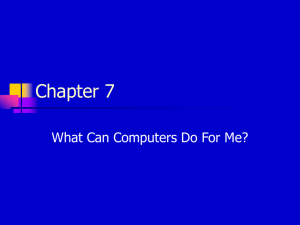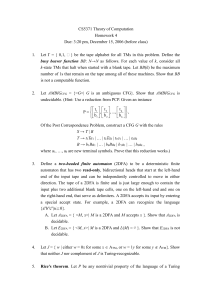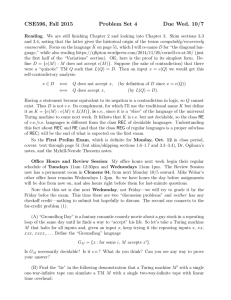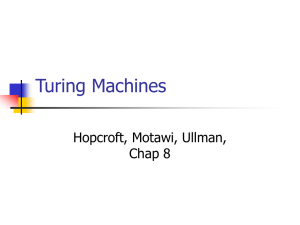TURING MACHINES
advertisement
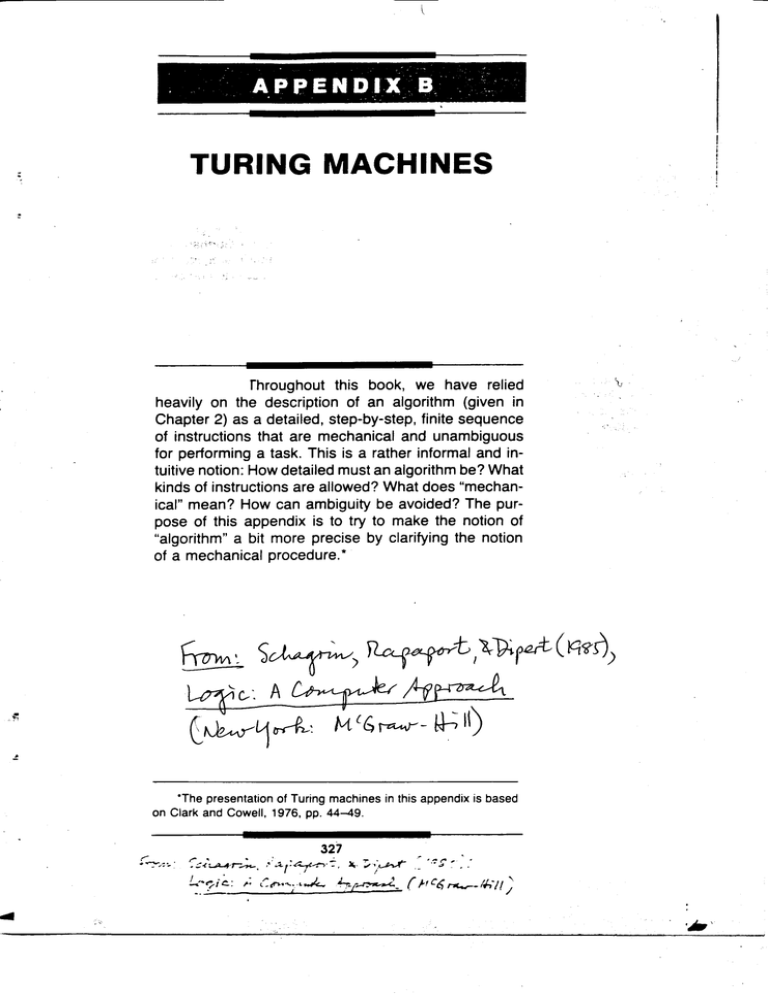
---
4
l
."--.:~_.c:~;o'~:o".:
[~r~ [~ [~ [(I l--,-=
I.:[~I~J,
.
"
"
"'
,,' ... .
",
!
i
TURING MACHINES
;:
1
rhroughout this book, we have relied
\;
heavily on the description of an algorithm (given in
Chapter 2) as a detailed, step-by-step, finite sequence
of instructions that are mechanical and unambiguous
for performing a task, This is a rather informal and intuitive notion: How detailed must an algorithm be? What
kinds of instructions are allowed? What does "mechanical" mean? How can ambiguity be avoided? The purpose of this appendix is to try to make the notion of
"algorithm" a bit more precise by clarifying the notion
of a mechanical procedure,*
~
~
Sv.t~.r-~ ~) 'C_C<f-e,l.f.(J.,l
~ I~
~~~~~~h~~~l~~~.,f.-~
M(6~~
c~
r(
~<6'.n)
1\)
~
"The presentation of Turing machines in this appendix is based
on Clark and Cowell, 1976. pp. 44-49.
,--
,- ,
,,~,,;,.'
. ';:.{:..,.a..of-r
':,
, .' ..~! .~~.
...,~ -- '~f",'.
..
..
327
..:.
.,. .
-. ~
'"
/
~'~:
~; r'-t'""",-;I...,I.:..~i~~=-
( frCL<j"r7(.,-_/";-II;
.
..'
~
~
:::~';~~':":~~JF
328
iI~t~f;~~1
APPENDIXB
Turing's
Analysis
of Computation
We have said that an algorithm is a "mechanical procedure" for carrying out some task
in a finite number of steps. If we limit ourselves to tasks that can be described in some
language (either a natural language or a programming language), then we can think of
such a procedure as a "computation." In 1937, the English logician Alan Turing (1912-1954)
presented an analysis of this notion in an important paper, "On Computable Numbers,
'.
;
with an Application to the Entscheidungsproblem,"
that led, among other things, to the
notion of the stored-program computer. (The English translation of the German word
;-'-
r~~':1 '
, ,..
~~""';-
Entscheidungsproblem
;f
a giventask will producea definite affirmativeor negativeanswer in a finite numberof
is "decision problem"-the
question of whether a procedure for
':;;ji
steps.)
Turing's analysis begins by considering what it means for a computation to be carried
.
out "mechanically." At the very least, we would need:
.,
~
~~
:1'f
4j"
"
1. A "computer"-either
a person or a machin~to
do the computation,
2. Some scratch paper (a memory device) to do the computation on,
3. A deterministic program for the computer to follow-that is, a finite sequence of
instructions for performing the computation by manipulating symbols on the scratch
paper.
We can refine this somewhat informal picture. Let us suppose that the mind of the
person (or computer) can only be in a finite number of different "states." Also, let's
suppose for the sake of convenience that the person (or computer) has memorized the
program (so that we only have to concern ourselves with two things: the computer and
the scratch-pad "memory").
As for the scratch-pad memory, let's suppose that we have lots of paper-not
necessarily an actually infinite amount of paper, but enough paper so that if we need
more, we can always get it. And, so that we can describe precisely what's written on
the paper, let's imagine that it is crosshatched into small squares (like graph paper),
each containing one symbol, so that we can systematically locate any symbol in any
square on any page of the scratch pad (for instance, by starting at the square in the
first row and first column of the first page and examining each square in turn until we
either find the symbol or else reach the last square on the last page without having
found it).
Finally, imagine that the person (or computer) doing the computing can only see a
finite. bounded number of squares on the scratch pad at anyone time.
..
As the next refinement, let us now assume the following:
.
1. The person (or computer) sees only one square (containing at most one symbol)
of the scratch pad at a time.
2. (a) The scratch pad is a linear tape (like an adding-machine tape), divided into
squares, that is potentially infinite in both directions (that is, we can always
add an extra square on either end).
.
j
.:.:~.
F';~'.
:~ ':::.0
"
J
.,
c
"1~
329
-
"
~
TURING MACHINES
I
I
I
I
I
I
I
I
I
Figure B-1 A Turing-machine tape.
~':
.
(b) Each square on the tape has a '1' or a 'a. printed on it at the start (this is
the input).
3. The program that the person (or computer) memorized doesn't consist of complex
instructions (such as "Find the word MULTIPLY on the tape"); instead. it consists
of a finite sequence of instructions of the following five kinds:
(a) START.
(b) IF your state of mind is P
and you are scanning symbol 5
THEN
(i) Change 5 to 5'.
(ii) Change your state of mind to Q.
(c) IF your state of mind is P
and you are scanning symbol 5
THEN
(i) Move 1 square to the right.
(ii) Change your state of mind to Q.
(d) IF your state of mind is P
and you are scanning symbol 5
THEN
(i) Move 1 square to the left.
(ii) Change your state of mind to Q.
(e) STOP.
Below, we shall make these instructions even more precise. The result of this is a "Turing
machine," which may be imagined as a physical machine on wheels. with a unit for
reading and writing on the tape and a "register" to indicate what state it is in.
Figure B.2 An imaginary.physicalTuringmachine.
Square De,nq
scanned
Readwr'te
scanner
FInIte amount of
CIrcuItry for
.
reoresentlng
the
algorIthm and
Ol"er states
~
State reg'ster
,,-
.
movIng
letlrlghl
,
t
~
II,
"
1;-!,
!
i~T:~
330
APPENDIX8
-
-
-
'
Turing Machines
A Turing machine can be defined as follows: It consists of a certain set, called the
memory set, and a program constructed from elements of specified sets of operations
and tests.
~
The memory set is the formal analog of the tape. Each element of the set consists
of two items: (1) a string of 'a's and '1's (representing the information stored on the tape)
and (2) a positive integer (representing the symbol currently being scanned by the Turing
machine). For instance,
1
~;50;",';;:-'
1
0 0
't,!!
-
1
Ii.
Scanner
-Jiiiif?:;-?c:c;
:,~~
Figure B-3 The Turing-machine tape represented by (11001, 4) or by 11OQ1.
-,- -;;;
would
v
be
represented
by
the
memory-set
(11001, 4)
::-i~
~lj~;
~-~.;~:;
where the first element of this pair is the string and the second is the square being
'--}::-;:~;\
scanned, or by the symbol
Ltl
.-/
?}
element
110Q1
where the underline represents the position of the scanner. The "empty" tape-the tape
with no little squares of paper-is represented by any element whose scanning number
is 0; we'll represent the empty tape with the symbol e.
The Turing-machine programming language (TM) that we shall use consists of seven
operations and four tests. The operations are:
1. START.
2. PRINT-a. This changes the symbol currently being scanned to O.More precisely,
PRINT-0 changes memory-state e to (0, 1) and memory-state s 1S2. . . Si-1§j
S'+1..
.SktOS1S2..
.Si-1QSi+1..
~
.Sk.(Ofcourse,ifs,wereOtobeginwith,PRINT-
~
a would not change the tape.)
3. PRINT -1. (Exercise: Describe the behavior of PRINT -1.)
~
4. LEFT. This moves the scanner one symbol to the left, adding on a new square
with a a in it if necessary. (Remember: Our Turing machine is on wheels; it
moves, not the tape.) More precisely, LEFT leaves memory-state e alone; it
changes S1 . . . §J . . . Sk to S1 . . . ~1Si . . . Sk; and it changes §.1. . . Sk to Qs1 . . . S/(.
.
I
j
!
I
~
I
~--
--
..J
.
-
r
f"
I
"
331
I
TURING MACHINES
5, RIGHT. This operation
moves the scanner
one symbol to the right, adding a new
square with a 0 in it if necessary, That is, it leaves e alone; it changes s, , . . §J . . , Sic
to S, . . . S;§j+, . . . Sic; and it changes
s, , , . §Jcto s, , . . s&.
6, ERASE, This operation does nothing unless the scanner is at the left-hand end
or the right-hand end of the tape, in which case it erases the symbol being
scanned and cuts off the square, That is, ERASE leaves e and s, . , , §J , , , Sic
.!
alone; but it changes ~,S2 . , . Sicto ~2 ' , , Sic,and it changes s, . . , SIc-'§Jcto s, , , . §Jc-,;
.
also, it causes a 1-square tape with only one symbol on it to disappear (that is,
~ becomes e).
7, STOP,
The tests are:
1, O? and 1? These two test whether the symbol being scanned is 0 or 1. Formally,
if the tape is e, then the result of the tests is FALSE; and if the tape is s, . , . §J . . . Sic,
then the result is TRUE if S; = S and FALSE otherwise (where S is 0 or 1,
depending on the test),
2. LEFTEND? Tests whether the scanner is at the left-hand end of the tape. If it
is, or if the tape is empty, the test result is TRUE; otherwise, it is FALSE.
3, RIGHTEND? Tests whether the scanner is at the right-hand end of the tape. If
it is, or if the tape is empty, the test result is TRUE; otherwise, it is FALSE,
Turing-Machine Programs
Let us see what some of our simple algorithms look like when translated into programs
in TM.
Negation
'
We'll begin with the algorithm for FNEG, that is, for computing the truth value of the
'
I
.
negation of a sentence (see Chapter 3). The first decision we need to make is how to
! .~
,
"code" truth values so that they can be expressed on the tape. One obvious way is to
represent a TRUE sentence with a 1-square tape containing a '1' and a FALSE sentence
with a 1-square tape containing a '0',
Next, we must decide what the output should look like. One possibility is to have
our algorithm end with a 2-square tape whose first symbol is the original truth value and
whose second symbol represents the negation of that truth value, with the scanner on
.
the second symbol. (Remember: We can add new squares to our tape whenever we
want.) Thus for input '1', the output would be '1Q', and for input 'Q', the output would be
'01',
So, we'll need to scan the input tape and, if there's a '1', move right and print a '0',
but if there's a 'Q', we'll move right and print a '1',
,
-
.
.
.
.
r
332
APPENDIXB
In TM we shall let the "states of mind" be represented by MOt M" M2t M3t etc. We
shall always begin (START) in the state of mind Mo. The program for computing FNEG
in the manner we have just described is:
1. START.
:.
2. IF you are in Mo and are scanning 0,
(a)THEN
RIGHT.
:
(b) Change state of mind to M,.
3. IF you are in Mo and are scanning 1,
THEN
(a) RIGHT.
(b) Change state of mind to M2.
4. IF you are in M, and are scanning 0,
THEN
(a) PRINT -1.
(b) Change state of mind to M2.
5. IF you are in M2'
THEN STOP.
Notice that you will never be in M, and scanning 1, so that possibility is not covered in
the program.
It is easier to represent the program using a flowchart, where your position on the
chart corresponds to a "state of mind":
START
TRUE
FALSE
RIGHT
RIGHT
,
PRINT-1
;!
STOP
Figure 8-4
TM program (in flowchart form) for computing the truth value of a negation.
!
I
i
.. ~,;:'~..(?,.1
---'=
334
APPENDIXB
START
.- ~.
"1 "':
"
TRUE
FALSE
.
I.
RIGHT
RIGHT
TRUE
FALSE
.
;-[~~;;,,~;,
':'"":0';.:,,
"~,-.,~':
RIGHT
RIGHT
Figure 8-5
RIGHT
TM program for computing the truth value of a conjunction.
, ~'C'
c'
9. An algorithm for adding two positive integers. Let the input-output coding be as
follows: The addition problem m + n will be representd by m '1's. followed by a
'0', followed by n '1's. A nice notation for this is:
1m01n
..
The output tape will consist of m + n '1's, that is:
~
1m+n
;:
Palindromes
.
.
As a final example of TM programming, we shall sketch out a program that decides if
the input tape contains a palindrome. A palindrome will be any string of 'O's and '1's
that reads the same backward and forWard. For instance,
.
t ::::::=:::::::::::=:::=::::=:::=======::::
I
' .
..l
335
TURINGMACHINES
000
~\:'
p'
010
;,
001100
:
-
are palindromes. but
,
01
110
0011110
are not. Clearly, a 1-square tape always contains a palindrome. It will be useful to consider
the empty tape to be a palindrome too.
The input will be a tape containing the string to be tested. with the scanner on the
first (leftmost) symbol. The output will be a 1-square tape with a '1' if the input is a
palindrome and a 'a' otherwise. Two examples are as follows:
Input
Output
101
lOa
1
Q
The algorithm that we shall use is the following:
.!
1. IF the tape is empty
THEN OUTPUT '1' [since it is a palindrome}.
2. IF the tape has only 1 square
THEN OUTPUT '1' [since it is a palindrome].
3. IF the tape has 2 or more squares
THEN
-;.
(a) Compare the symbol in the leftmost square with the symbol in the
rightmost square.
(b) IF they match
THEN
(i) Erase both symbols.
(ii) GO TO step 1.
(c) IF they do not match
THEN
(i) Erase the tape.
(ii) OUTPUT '0' [since it is not a palindrome].
4. STOP.
,.-
(You should try this algorithm on a few examples to convince yourself that it works.)
This time, we shall use top-down design and stepwise refinement to write the
~rogram (and we shall leave some of t~e details as exercises). To do .this, we shall
Int~oduce a new fI~wchart sym~ol-a circle-to represent steps that will have to be
j
1
!
refined Into the basIc TM operatIons and tests.
The top-level program is:
I
!
1
--"
START
PRINT-1
STOP
.
E
TRUE (:.Ieft-most symbol is 0)
FALSE (:. left-most symbol is 1)
ERASE
ERASE
5
FALSE
TRUE
TRUE
ERASE
ERASE
PRINT -0
~
!.
STOP
Figure 8-6
TM program for the palindrome problem.
.
.
C-""~ --~
I
I
p,:~"
"~l;'~
,"'..
,
337
- TURING MACHINES
The circles labeled 1 to 5 represent procedures that must be refined. Here is the refinement of procedure 1:
START
TRUE
FALSE
TRUE
!
i
(i.e., the tape
is not blank)
FALSE
True halt
(i.e., the tape
is not blank)
Figure
B-7
TM program
And here is the refinement
for procedure
of procedure
1 of the palindrome
program.
5:
'
,Ii;:.~
;:'
START
..:,'-
';",
ERASE
,,:;0\;:;
:;~\,,:,..'.
;0
~
FALSE
Figure B-8
i
"
~
TM program
TRUE
for procedure
STOP
5 of the palindrome
program.
!
~
!
I
..
338
I
APPENDIXB
:I
.
;
i
Exercises
,c
10.
11.
12.
13.
14.
Refine
Refine
Refine
Refine
Refine
procedure 2.
procedure 3.
procedure 4.
the given refinement of 5 (in Figure B-8).
procedure 5 without using procedure 1. (Hint: Use LEFTEND?)
Church's
~
~
Thesis
Let us consider the relationship between a Turing machine and our notion of an algorithm.
One version of Church's thesis (see Chapter 14), known as the Church-Turing
thesis, says that our intuitive notion of a mechanical computation can be defined as any
computation that can be carried out by a Turing machine. This cannot be proved (because
our notion of a mechanical computation is intuitive and vague, and proofs require precise
notions), but there is a substantial amount of evidence to suggest the following two
points:
1. Any computation that seems intuitively "mechanical" can be carried out on a
Turing machine.
2. Any computation that can be carried out on a Turing machine is intuitively "mechanical."
The main evidence for statement 2 is Turing's analysis of computation that we
discussed in an earlier section. It seems, intuitively, that any computation that can be
done by a Turing machine is intuitively mechanical.
We said that the thesis cannot be proved; but if it is false, then it can be falsified:
If anyone were to deny the Church-Turing thesis, it would have to be because he or she
denied statement 1, that is, claimed that there might be an intuitively mechanical procedure that a Turing machine could not carry out-that, perhaps, Turing machines, with
all their limitations of size and of operations, were not powerful enough. (After a", those
instructions seem rather simplistic, especially if the only symbols allowed are '0' and
'1 '.)
But there are two sorts of evidence in favor of statement 1. First, there is empirical
evidence: All (intuitively mechanical) procedures that have been constructed so far can
be translated into Turing-machine programs.
Second, all "rival" theories of what might count as being "mechanically computable"
have turned out to be equivalent to the theory of Turing-machine computability.
Some of these other theories of what is "mechanically computable" are:
~
~
1. Church's lambda calculus-the
notion he used in the original formulation of the
thesis; it was later used as the basis for the programming language LISP.
2. Markov algorithms-which
later became the basis for the programming language
SNOBOL.
. .
!
i
"'-'
~-"'-
~"--
339
.
TURINGMACHINES
,
3. The theory of partial-recursive functions, which lies at -the foundation of Gbdel's
incompleteness theorem, and which also can be considered to underlie much
r.
of the recent theory of "structured" programming.
4. The Herbrand-Gbdel theory of recursion equations-which
later became the
basis for the programming language ALGOL (and thus, indirectly, its descendant
Pascal).
5. The theory of register machines-which
.
is a mathematical analogue of a "von
Neumann"
digitalcomputer.
"~
~",~
..
.
,'I.'
..
,
1111
L
